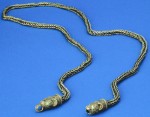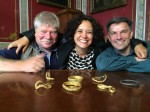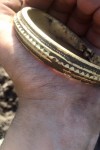 Three metal detectorists have discovered a group of bangles which add up to the greatest amount of Viking gold ever found in Denmark. Last week Marie Aagaard Larsen, her husband Christian Nedergaard Dreiøe and their friend Poul Nørgaard, aka Team Rainbow Power, were scanning a field in Vejen, south Jutland, where a gold chain from the Viking era had been discovered in 1911. Ten minutes after they started, Poul struck gold. They unearthed a gold bangle that they recognized was old, but it was bigger than anything quite they’d encountered before.
Three metal detectorists have discovered a group of bangles which add up to the greatest amount of Viking gold ever found in Denmark. Last week Marie Aagaard Larsen, her husband Christian Nedergaard Dreiøe and their friend Poul Nørgaard, aka Team Rainbow Power, were scanning a field in Vejen, south Jutland, where a gold chain from the Viking era had been discovered in 1911. Ten minutes after they started, Poul struck gold. They unearthed a gold bangle that they recognized was old, but it was bigger than anything quite they’d encountered before.
 Team Rainbow Power emailed a photograph of the artifact to the Museum Sønderskov in nearby Brørup. Curator and archaeologist Lars Grundvad was amazed to see what they’d found. He and his colleagues had discussed returning to that field to explore it further because of the gold chain weighing 67 grams that had been unearthed there in 1911, but in his wildest dreams he hadn’t imagined there would be multiple finds of such quality and size.
Team Rainbow Power emailed a photograph of the artifact to the Museum Sønderskov in nearby Brørup. Curator and archaeologist Lars Grundvad was amazed to see what they’d found. He and his colleagues had discussed returning to that field to explore it further because of the gold chain weighing 67 grams that had been unearthed there in 1911, but in his wildest dreams he hadn’t imagined there would be multiple finds of such quality and size.
 Within 15 minutes, they found another gold piece. Then they found another. In the final tally, Team Rainbow Power discovered six gold and one silver bangle. The total weight of the gold bangles is 900 grams, just shy of two pounds. The previous record holder for the greatest amount of gold from a Viking treasure was the hoard found in Vester Vedsted, Southwest Jutland, in 1859. That hoard contained two gold neck rings, five gold bangles, a fragment of gold chain, two filigree pendants and two gold beads which totalled 750 grams. The Vejen find beats it by a lot in just six bangles, which goes to show just how big these pieces are. The sole silver bangle is a hefty one too at 90 grams (3.17 ounces). The bangles were likely buried together with the previously unearthed chain in the 10th century.
Within 15 minutes, they found another gold piece. Then they found another. In the final tally, Team Rainbow Power discovered six gold and one silver bangle. The total weight of the gold bangles is 900 grams, just shy of two pounds. The previous record holder for the greatest amount of gold from a Viking treasure was the hoard found in Vester Vedsted, Southwest Jutland, in 1859. That hoard contained two gold neck rings, five gold bangles, a fragment of gold chain, two filigree pendants and two gold beads which totalled 750 grams. The Vejen find beats it by a lot in just six bangles, which goes to show just how big these pieces are. The sole silver bangle is a hefty one too at 90 grams (3.17 ounces). The bangles were likely buried together with the previously unearthed chain in the 10th century.
It’s not unusual for objects from the same hoard to be found at different times, even a century apart. Buried hoards could be broken up and scattered over a wide area by centuries of agricultural activity, and since metal detectors only began to be used in Denmark in the 1980s, even archaeological excavations were unlikely to find every artifact.
“Finding just one of these bangles is massive, so finding seven is something very special,” said Peter Pentz, a Viking expert and curator from the National Museum of Denmark.
Pentz went on to explain that silver was the most used metal during the Viking Age, which makes the golden find even more audacious.
 One of the gold pieces is decorated in the stylized animal figures characteristic of the Jelling style, as is the chain discovered in 1911. The Jelling style in particular is associated with the elite of Viking society and considering the richness of the find, the Vejen area was likely home to a person of great wealth and position. The bangles could have been gifts for allies, rewards for his best men or oath rings. The style also helps date the hoard because it was in vogue for a short period from the first half of the 10th century until the year 1000 when it disappears from the archaeological record.
One of the gold pieces is decorated in the stylized animal figures characteristic of the Jelling style, as is the chain discovered in 1911. The Jelling style in particular is associated with the elite of Viking society and considering the richness of the find, the Vejen area was likely home to a person of great wealth and position. The bangles could have been gifts for allies, rewards for his best men or oath rings. The style also helps date the hoard because it was in vogue for a short period from the first half of the 10th century until the year 1000 when it disappears from the archaeological record.
 The precise location of the find is being kept secret for now as Team Rainbow Power, in collaboration with the Museum Sønderskov, is still searching the field. Lars Grundvad is working on raising funds now for a full archaeological investigation of the find site to take place as early as this fall. The museum hopes to display the finds before they are transferred to the National Museum in Copenhagen, where they will be studied and evaluated as treasure trove. Team Rainbow Power will receive treasure trove compensation based on the National Museum’s assessment.
The precise location of the find is being kept secret for now as Team Rainbow Power, in collaboration with the Museum Sønderskov, is still searching the field. Lars Grundvad is working on raising funds now for a full archaeological investigation of the find site to take place as early as this fall. The museum hopes to display the finds before they are transferred to the National Museum in Copenhagen, where they will be studied and evaluated as treasure trove. Team Rainbow Power will receive treasure trove compensation based on the National Museum’s assessment.